Frigidaire LFGS3025PFH, FPGS3085PFG, FPGS3085PFD, FPGS3085PFC, FPGS3085PFB Owner’s Manual
...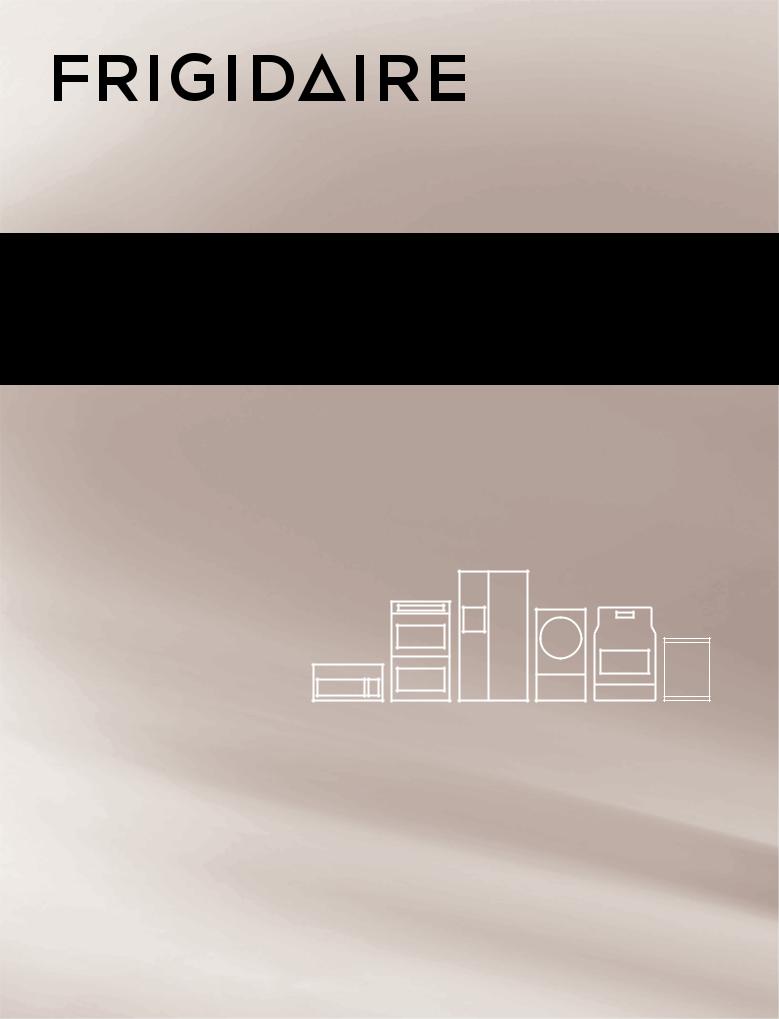
All about the
Use&Care
of your Gas Range
|
TABLE OF CONTENTS |
|
|
Product Record and Registration . . . . . . . |
. . . . . . . 2 |
Oven Controls . . . . . . . . . . . . . . . . . . . . . . . . . . . . |
13 |
Important Safety Instructions . . . . . . . . . . |
. . . . . . . 3 |
Care and Cleaning . . . . . . . . . . . . . . . . . . . . . . . . |
30 |
Before Setting Surface Controls . . . . . . . . . |
. . . . . . 8 |
Warranty . . . . . . . . . . . . . . . . . . . . . . . . . . . . . . . . |
37 |
Before Setting Oven Controls . . . . . . . . . . . |
. . . . . 11 |
|
|
www.frigidaire.com USA 1-800-944-9044 |
www.frigidaire.ca Canada 1-800-265-8352 |
2014) (March C Rev 139901501
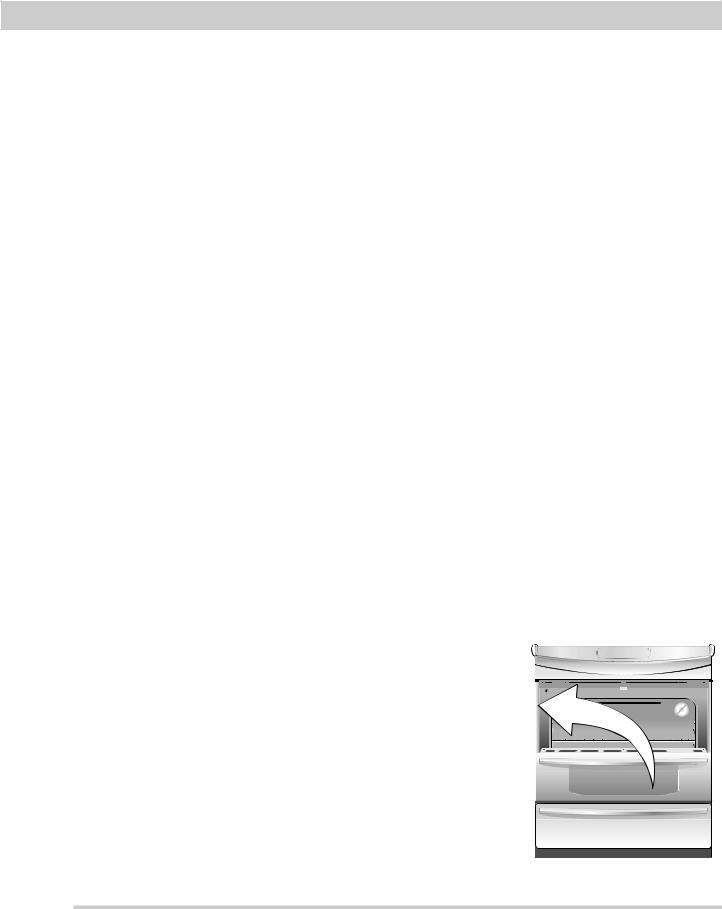
PRODUCT RECORD AND REGISTRATION
Need Help? . . . . . . . . . . . . . . . . . . . . . . . . . . . . . . . . .2 Registering your Frigidaire product helps us to serve you. Register online at www.frigidaire.com or by dropping your Product Registration Card in the mail. . . . . .2
Product Record and Registration . . . . . . . . . . . . . . . . . 2 Important Safety Instructions . . . . . . . . . . . . . . . . . . . . 3 Before Setting Surface Controls . . . . . . . . . . . . . . . . . . 8 Before Setting Oven Controls . . . . . . . . . . . . . . . . . . 11 Oven Controls . . . . . . . . . . . . . . . . . . . . . . . . . . . . . . . 13
. . . . . . . . . . . . . . . . . . . . . . . . . . . . . . . . . . . . . . . . .13
Care and Cleaning . . . . . . . . . . . . . . . . . . . . . . . . . . . . 30 Warranty . . . . . . . . . . . . . . . . . . . . . . . . . . . . . . . . . . . . 37
Thank you for choosing Frigidaire.
Important: This Use and Care Guide is part of our commitment to customer satisfaction and product quality throughout the service life of your new appliance. We view your purchase as the beginning of a relationship. To ensure our ability to continue serving you, please use this page to record important product information.
Need Help?
Visit the Frigidaire web site at www.frigidaire.com
Before you call for service, there are a few things you can do to help us serve you better.
Read this Use & Care Manual
This manual contains instructions to help you use and maintain your range properly.
If You Received a Damaged Range...
Immediately contact the dealer (or builder) that sold you the range.
Save Time and Money
Check the section title “Before You Call”. This section helps step you through some common problems that might occur.
If you do need service, help is only a phone call away. Call Frigidaire Customer Services at 1-800-944-9044.
Registering your Frigidaire product helps us to serve you. Register online at www.frigidaire.com or by dropping your Product Registration Card in the mail.
Record model & serial numbers here
Purchase Date______________________________
Frigidaire model number_________________________
Frigidaire serial number__________________________
Serial Plate Location
Questions?
For toll-free telephone support in the U.S. or Canada call 1-
800-944-9044
For online support and Internet production information visit http://www.frigidaire.com.
2 |
2013 Electrolux Home Products, Inc. |
All rights reserved. Printed in the USA |
|

IMPORTANT SAFETY INSTRUCTIONS
CAUTIONS & WARNINGS
Read all instructions before using this appliance!
This manual contains important safety symbols and instructions. Please pay attention to these symbols and follow all instructions given. Do not attempt to install or operate your appliance until you have read the safety precautions in this manual. Safety items throughout this manual are labeled with a WARNING or CAUTION statement based on the risk type.
DEFINITIONS

 This is the safety alert symbol. It is used to alert you
This is the safety alert symbol. It is used to alert you to potential personal injury hazards. Obey all safety messages that follow this symbol to avoid possible injury or death.
to potential personal injury hazards. Obey all safety messages that follow this symbol to avoid possible injury or death.
 WARNING
WARNING
Indicates a potentially hazardous situation which, if not avoided, may result in death or serious injury.
 CAUTION
CAUTION
Indicates a potentially hazardous situation which, if not avoided, may result in minor or moderate injury.
 IMPORTANT
IMPORTANT
Indicates installation, operation, maintenance, or valuable information that is not hazard related.
 WARNING
WARNING
•Do not leave children alone - children should not be left alone or unattended in the area where appliance is in use. They should never be allowed to sit or stand on any part of the appliance, including the storage drawer, lower broiler drawer, warmer drawer, or lower double oven.
•Stepping, leaning or sitting on the door or drawers of a range can result in serious injuries and also cause damage to the appliance. Do not
allow children to climb or play around the range. The weight of a child on an open oven door, may cause the range to tip, resulting in serious burns or other injury.
WARNING! If the information in this manual is not followed exactly, a fire or explosion may result causing property damage, personal injury or death.
FOR YOUR SAFETY:
Do not store or use gasoline or other flammable vapors and liquids in the vicinity of this or any other appliance.
WHAT TO DO IF YOU SMELL GAS:
•Do not try to light any appliance.
•Do not touch any electrical switch; do not use any phone in your building.
•Immediately call your gas supplier from a neighbor's phone. Follow the gas supplier's instructions.
•If you cannot reach your gas supplier, call the fire department.
•Installation and service must be performed by a qualified installer, service technician or the gas supplier.
 IMPORTANT
IMPORTANT
Important Safety Notice - The California Safe Drinking Water and Toxic Enforcement Act requires the Governor of California to publish a list of substances known to cause cancer, birth defects or other reproductive harms, and requires businesses to warn customers of potential exposures to such substances.
 WARNING
WARNING
Do not store or use gasoline or other flammable vapors and liquids in the vicinity of this or any other appliance.
3
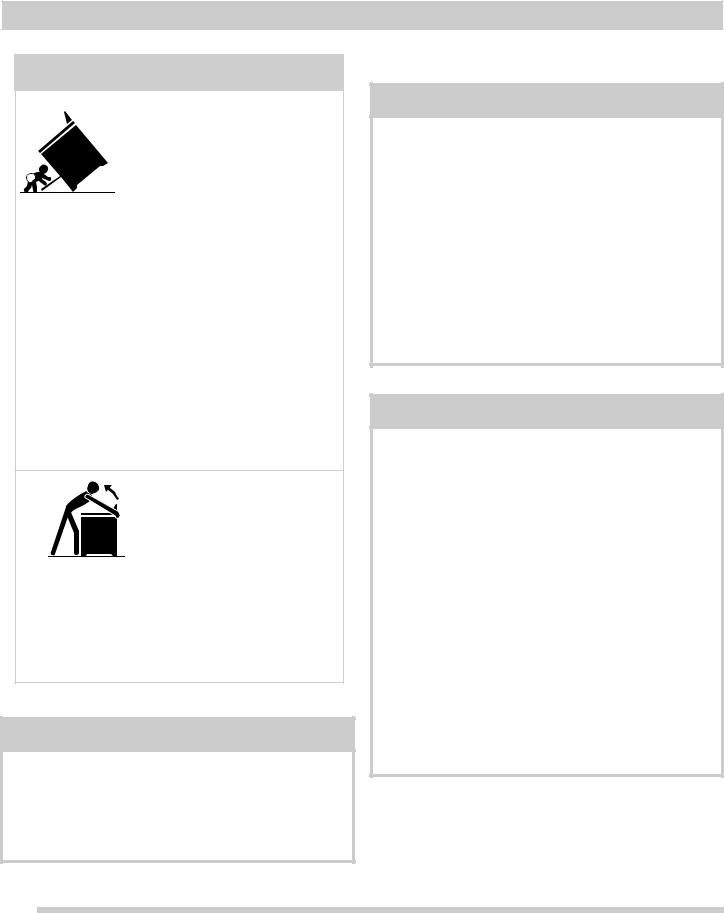
IMPORTANT SAFETY INSTRUCTIONS
 WARNING
WARNING
Tip Over Hazard
•A child or adult can tip the appliance and be killed.
• Verify the device is
engaged with the countertops or that the
device has been installed to the walls of the cabinet, the wall, or the floor as per the installation instructions
•Ensure the anti-tip device is re-engaged with the countertop, the walls of the cabinet, the wall, or the floor as per the installation instructions when the appliance is moved.
•Do not operate the appliance without the anti-tip device in place and engaged.
•Failure to follow these instructions can result in death or serious burns to children and adults.
To check if the anti-tip bracket is installed properly, use both arms to grasp the rear edge of the appliance back. Carefully attempt to tilt
appliance forward. When properly installed, the appliance should not tilt forward.
Refer to the anti-tip bracket installation instructions supplied with your range for proper installation.
 WARNING
WARNING
Personal injury or death from electrical shock may occur if the conversion to L.P. gas is not made by a qualified installer or electrician. Any additions, changes or conversions required in order for this appliance to satisfactorily meet the application needs must be made by a qualified technician.
 WARNING
WARNING
•Storage in or on appliance—flammable materials should not be stored in an oven, near surface units, or in the storage drawer, warmer drawer, or lower oven. This includes paper, plastic and cloth items such as cookbooks, plastic ware and towels, as well as flammable liquids. Do not store explosives, such as aerosol cans, on or near the range.
•Never cover any slots, holes, or passages in the oven bottom or cover an entire oven rack with materials such as aluminum foil. Aluminum foil linings may trap heat, causing a fire hazard.
 IMPORTANT
IMPORTANT
•Do not operate range during a power failure. If power fails, turn off range. If range is not turned off and power resumes, the range may begin to operate again. Once the power resumes, reset the clock and oven function.
•Cold temperatures can damage the electronic control. When using this appliance for the first time, or when the appliance has not been used for an extended period of time, be sure the appliance has been in temperatures above 32ºF (0ºC) for at least 3 hours before turning on the power to the appliance.
•Remove the oven door from any unused range if it is to be stored or discarded.
•Be sure to have an appropriate foam-type fire extinguisher available, visible, and easily accessible located near the appliance.
4

IMPORTANT SAFETY INSTRUCTIONS
 IMPORTANT
IMPORTANT
Read and follow these instructions and precautions for unpacking, installing, and servicing your appliance:
•Remove all tape and packaging before using the range. Destroy the carton and plastic bags after unpacking the range. Never allow children to play with packaging material.
•Proper Installation—Be sure your appliance is properly installed and grounded by a qualified technician in accordance with the National Fuel Gas Code ANSI Z223.- latest edition, or in Canada CAN/CGA B149.1, and CAN/CGA B149.2, and the National Electrical Code ANSI/ NFPA No.70-latest edition, or in Canada CSA Standard C22.1, Canadian Electrical Code, Part 1, and local code requirements. Install only per installation instructions provided in the literature package for this range. Ask your dealer to recommend a qualified technician and an authorized repair service. Know how to disconnect the power to the range at the circuit breaker or fuse box in case of an emergency.
•User servicing—Do not repair or replace any part of the appliance unless specifically recommended in the manuals. All other servicing should be done only by a qualified technician. This reduces the risk of personal injury and damage to the range. Ask your dealer to recommend a qualified technician and an authorized repair service. Know how to disconnect the power to the range at the circuit breaker or fuse box in case of an emergency.
•Remove the oven door from any unused range if it is to be stored or discarded.
•Never modify or alter the construction of a range by removing the leveling legs, panels, wire covers, anti-tip brackets/screws, or any other part of the range.
 CAUTION
CAUTION
•Do not store items of interest to children in the cabinets above a range on the backguard of the ranges. Children climbing on the range to reach items could be seriously injured.
•Do not touch surface heating units or surface cooking elements, areas near these units or elements, or interior surface of the oven. Surface heating areas and oven heating elements may be hot even though they appear cool. Areas near surface cooking units may become hot enough to cause burns. During and after use, do not touch, or let clothing or other flammable materials touch these areas until they are cool. These areas may include the cook top, surfaces facing the cook top, oven vent areas, oven door, and oven window.
•Wear proper apparel. Loose-fitting or hanging garments should never be worn while using this appliance. Do not let clothing or other flammable materials come into contact with hot surfaces.
•Do not heat unopened food containers. Build-up of pressure may cause container to burst and result in injury.
•When heating fat or grease, watch it closely. Fat or grease may catch fire if it becomes too hot.
•Do not use water or flour on grease fires. Cover the fire with a pan lid, use baking soda, or use a dry chemical or foam type extinguisher.
•Use dry potholders. Moist or damp potholders on hot surfaces may result in burns from steam. Do not let potholders touch hot cooking areas. Do not use towels or other bulky cloths.
5

IMPORTANT SAFETY INSTRUCTIONS
IMPORTANT INSTRUCTIONS FOR USING YOUR OVEN
•Never use the appliance for warming or heating the room. Doing so may result in carbon monoxide poisoning.
•Use care when opening oven door, lower oven door, or warmer drawer (some models). Stand to the side of the range when opening the door of a hot oven. Let hot air or steam escape before you remove or replace food in the oven.
•Keep oven vent ducts clear. Touching surfaces in this area when the oven is on may cause severe burns. Do not place plastic or heat-sensitive items on or near the oven vent. These items can melt or ignite.
•Always handle oven racks when the oven is cool. Place oven racks in desired positions while the oven is cool. If a rack must be moved while the oven is hot, use extreme caution. Use potholders and grasp the rack with both hands to reposition. Do not let potholders contact the hot heating elements in the oven. Remove all cookware and utensils before moving the rack.
•Do not use a broiler pan without its insert. Do not cover the broiler insert with aluminum foil; exposed fat and grease could ignite.
•Do not use aluminum foil or other protective liners to line the oven bottom. Only use aluminum foil as recommended in this manual. Improper installation of these liners may result in risk of electric shock or fire.
•Do not cook food on the oven bottom. Always cook in proper cookware and always use the over racks.
IMPORTANT INSTRUCTIONS FOR USING YOUR COOK TOP
 WARNING
WARNING
Use Proper Flame Size — Adjust flame size so it does not extend beyond the edge of the utensil. The use of undersized utensils will expose a portion of the burner flame to direct contact and may result in ignition of clothing.
Air curtain or other overhead range hoods, which operate by blowing a downward air flow on to a range, shall not be used in conjunction with gas ranges other than when the hood and range have been designed, tested and listed by an independent test laboratory for use in combination with each other.
•Know which knob controls each surface burner. Place a pan of food on the burner before turning it on, and turn the burner off before removing the pan.
•Always turn knob to the full LITE position when igniting top burners and check that burner has lit. Adjust flame so it does not extend beyond the edge of cookware.
•Utensil handles should be turned inward and not extend over adjacent surface burners.
•Never leave surface burners unattended at high heat settings — spill overs cause smoking and greasy spills that may ignite, or a pan that has boiled dry may melt.
•Glazed cooking utensils — Only certain types of cookware are suitable for cook top service without breaking due to the sudden change in temperature. Check the manufacturer’s recommendations for cook top use.
•When you are flaming foods under a ventilating hood, turn the fan on.
6

IMPORTANT SAFETY INSTRUCTIONS
IMPORTANT INSTRUCTIONS FOR CLEANING YOUR RANGE
 CAUTION
CAUTION
Before manually cleaning any part of the range, be sure all controls are turned off and the range is cool. Cleaning a hot range can cause burns.
•Clean the range regularly to keep all parts free of grease that could catch fire. Pay particular attention to the area around each burner element. Do not allow grease to accumulate.
•Always follow the manufacturer’s recommended directions for use of kitchen cleaners and aerosols. Be aware that excess residue from cleaners and aerosols may ignite causing damage and injury.
•Clean ventilating hoods frequently. Grease should not be allowed to accumulate on the hood or filter. Follow the manufacturer’s instructions for cleaning hoods.
SELF-CLEANING OVENS
•Use the self-clean cycle to clean only the parts listed in this manual. Before using self-clean, remove the broiler pan, any food, utensils, and cookware from the oven. Remove oven racks unless otherwise instructed.
•Do not use oven cleaners. No commercial oven cleaner, oven liner, or protective coating of any kind should be used in or around any part of the oven.
•Do not clean the oven door gasket. The door gasket is essential for a good seal. Do not rub, damage, or move the gasket.
•Some birds are extremely sensitive to the fumes given off during the self-clean cycle of any range. Move birds to another well-ventilated room.
CONVERSION TO L.P. GAS
This appliance allows for conversion to Liquefied Petroleum (L.P.) Gas.
If L.P. conversion is needed, contact your local L.P. Gas provider for assistance. The L.P. conversion kit is provided with this appliance and is located on the lower rear (back side) panel of the range. Before installing the kit be sure to read the L.P. Installation Instructions and follow them carefully when making the installation.
GROUNDING INSTRUCTIONS
For personal safety, the cook top must be properly grounded. For maximum safety, the power cord must be plugged into an electrical outlet that is correctly polarized and properly grounded. Do not operate the cook top using a 2-prong adapter or an extension cord. If a 2-prong wall receptacle is the only available outlet, it is the personal responsibility of the consumer to have it replaced with a properly grounded 3-prong wall receptacle installed by a qualified electrician.
See the installation instructions packaged with this cook top for complete installation and grounding instructions.
Grounding type |
|
wall receptacle |
Do not cut, remove, or |
|
bypass the grounding |
|
plug under any |
|
circumstances. |
Power supply cord with 3-prong grounding plug
 WARNING
WARNING
Avoid fire hazard or electrical shock. Do not use an adapter plug, and extension cord, or remove grounding prong from the power cord. Failure to follow this warning may cause serious injury, fire, or death. This appliance is equipped with a 3-prong grounding plug. For your protection it should be plugged directly into a properly grounded receptacle. Do not cut or remove the grounding prong from this plug.
7

BEFORE SETTING SURFACE CONTROLS
Control locations of the gas surface burners
Your built-in range is equipped with gas surface burners with different BTU ratings. The ability to heat food quicker and in larger volumes increases as the burner size increases.
The small simmer burner is best used for simmering delicate sauces, etc. This burner is located at the right rear burner position on the cooktop (see Figure 1). The standard burner can be used for most surface cooking needs. The standard burners are located at the left front and left rear positions on the cooktop.
The power burners are best used for bringing large quantities of liquid rapidly up to temperature or when preparing larger quantities of food. The power burner is located at the right front position on the cooktop.
Regardless of size, always select cookware that is suitable for the amount and type of food being prepared. Select a burner and flame size appropriate to the pan. Never allow flames to extend beyond the outer edge of the pan.
Never straddle two burners with cookware unless specifically designed for that purpose such as griddles.
Figure 1: Burner locations
Assembly of the surface burner caps and burner grates
It is very important to make sure that all of the surface burner caps and surface burner grates are installed correctly and at the correct locations.
1.Remove all packing material from cooktop area.
2.Discard all packing material (if applicable).
3.Unpack burner grates and position on the cooktop.
 IMPORTANT
IMPORTANT
Do not allow spills, food, cleaning agents or any other material to enter the gas orifice holder opening.
Always keep the burner caps and burner heads in place whenever the surface burners are in use.
Burner cap
Burner cap lip
Burner head
Correct burner cap |
Incorrect burner cap |
placement |
placement |
Operating the gas surface controls
1.Place cooking utensil on surface burner.
2.Push the surface control knob down and turn counterclockwise out of the OFF position.
3.Release the knob and rotate to the LITE position (see figures 1 & 2). Note: All four electronic surface ignitors will spark at the same time. However, only the burner you are turning on will ignite.
4.Visually check that the burner has a flame.
5.Turn the control knob counterclockwise to the desired flame size. The control knobs do not have to be set at a particular setting. Use the knob indicator settings to adjust the flame as needed. Do not cook with the surface control knob in the LITE position. (The electronic ignitor will continue to spark if the knob is left in the LITE position.
8
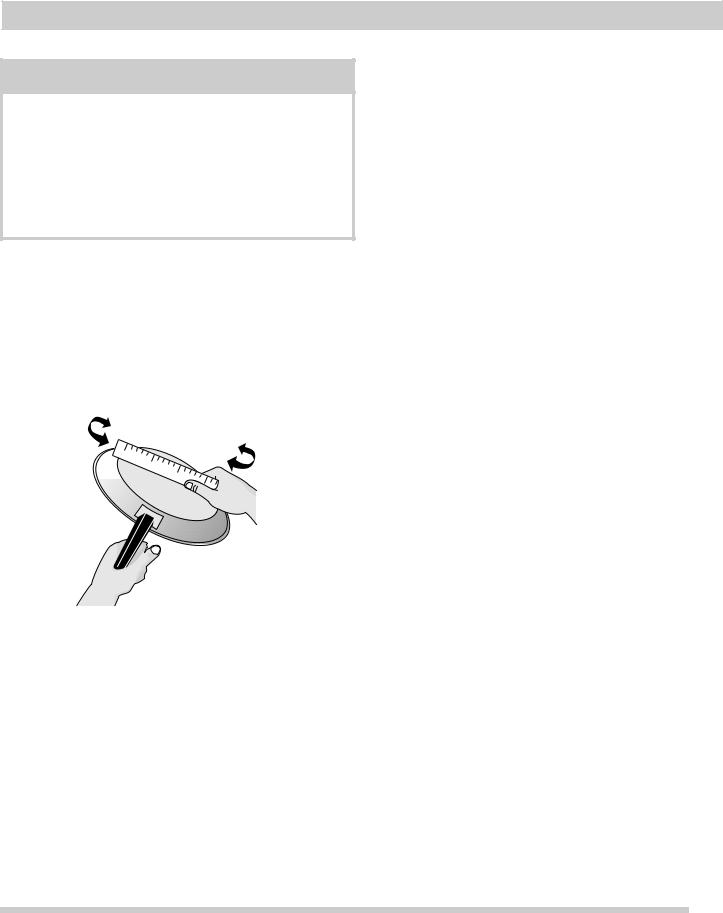
BEFORE SETTING SURFACE CONTROLS
Using Proper Cookware
 CAUTION
CAUTION
Do not place plastic items such as salt and pepper shakers, spoon holders or plastic wrappings on top of the range when it is in use. These items could melt or ignite. Pot holders, towels or wood spoons could catch fire if placed too close to a flame.
Do not operate the burner for an extended period of time without cookware on the grate. The finish on the grate may chip without cookware to absorb the heat.
Important: Do not place aluminum foil or any material that can melt on the range cooktop. If these items melt they may damage the cooktop.
For best cooking results, cookware should have flat bottoms that rest level on the burner grate. Before using cookware, check for flatness by rotating a ruler across the bottom of the cookware (Figure 2).
Figure 2: Checking pan for flat bottom
Please note: The size and type of utensil used, and the amount and type of food being cooked will influence the burner flame setting needed for best cooking results.
Cookware Material Types
The most popular materials available are:
•Aluminum
Excellent heat conductor. Some types of food will cause it to darken (Anodized aluminum cookware resists staining & pitting).
•Copper
Excellent heat conductor but discolors easily.
•Stainless
Slow heat conductor with uneven cooking results. Durable, easy to clean and resists staining.
•Cast Iron
A slow heat conductor however will retain heat very well. Cooks evenly once cooking temperature is reached.
•Porcelain - enamel on metal
Heating characteristics will vary depending on base material.
•Glass
Slow heat conductor.
Important: Do not straddle cookware between two burners unless the cookware is designed specifically for that purpose as is the case when using griddles.
9
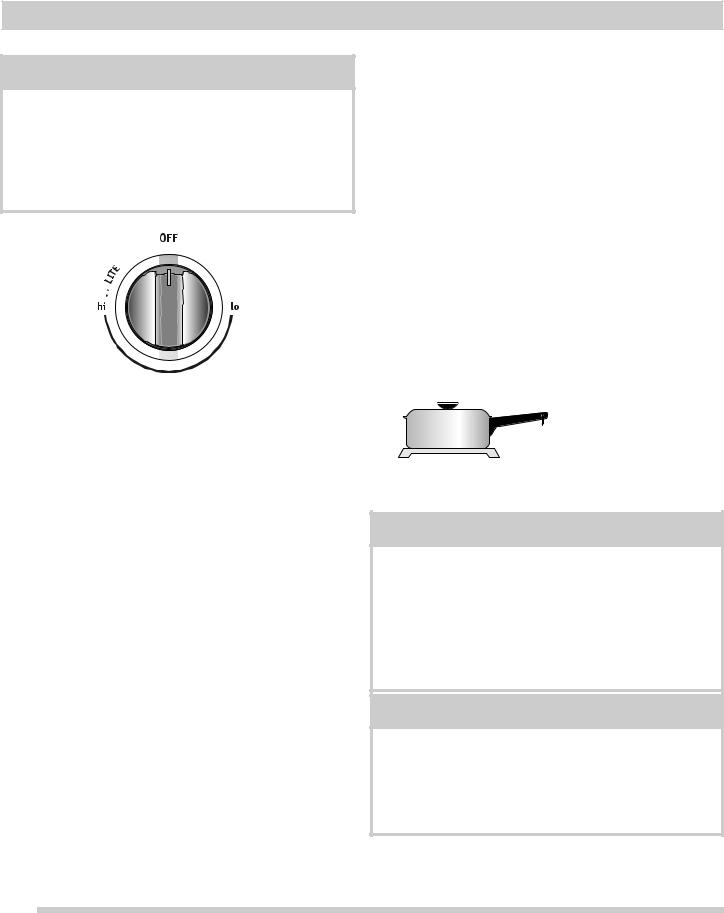
BEFORE SETTING SURFACE CONTROLS
)
 CAUTION
CAUTION
Do not place plastic items such as salt and pepper shakers, spoon holders or plastic wrappings on top of the range when it is in use. These items could melt or ignite. Pot holders, towels or wood spoons could catch fire if placed too close to a flame. Do not operate the burner for an extended period of time without cookware on the grate.
Figure 3: Gas knob LITE position
Home Canning
Be sure to read and observe all the following points when home canning with your appliance.
Check with the United States Department of Agriculture (USDA) website and be sure to read all the information they have available as well as follow their recommendations for home canning procedures.
•Use only quality flat bottom canners when home canning. Use a straight-edge to check canner bottom.
•Use only a completely flat bottom canner with no ridges that radiate from the bottom center when home canning using a ceramic cooktop.
•Make sure the diameter of the canner does not exceed 1 inch beyond the surface element markings or burner. It is recommended to use smaller diameter canners on electric coil and ceramic glass cooktops.
•Start with hot tap water to bring water to boil more quickly. Use the highest heat seating when first bringing the water to a boil. Once boiling is achieved, reduce heat to lowest possible setting to maintain that boil.
•Never place or straddle a cooking utensil over two different surface cooking areas at the same time. This will cause uneven heating results and may cause the ceramic cooktop to fracture.
Setting proper surface burner flame size
For most cooking: Start on the highest control setting and then turn to a lower one to complete the process. Use the recommendations below as a guide for determining proper flame size for various types of cooking. The size and type of utensil used and the amount of food being cooked will influence the setting needed.
Flame Size |
|
Type of Cooking |
||||
|
|
|
|
|
|
|
High Flame |
• |
Star most foods |
||||
|
|
|
• Bring water to a boil |
|||
|
|
|
• |
Pan broiling |
||
|
|
|
|
|
|
|
Medium Flame |
• |
Maintain slow boil |
||||
|
|
|
• |
Thicken sauces and |
||
|
|
|
|
|
gravies |
|
|
|
|
• |
Steaming foods |
||
|
|
|
|
|
|
|
Low Flame |
• |
Keep foods cooking, |
||||
|
|
|
|
|
poaching and stewing |
|
|
|
|
|
|
|
|
|
|
|
|
|
|
|
Correct |
Incorrect |
Figure 4: Gas flame adjustment
 IMPORTANT
IMPORTANT
Never extend the flame beyond the outer edge of the utensil. A higher flame simply wastes heat and energy, and increases the risk of being burned by the gas flame.
In the event of an electrical power outage, the surface burners can be lit manually. To light a surface burner, hold a lit match to the burner head, then slowly turn the surface control knob to LITE. After burner lights turn the knob to desired setting.
 NOTE
NOTE
Settings based on using medium weight metal or aluminum pans. Settings may vary using other types of pans. The color of the flame is key to proper burner adjustment. A good flame is clear, blue, and hardly visible in a well-lighted room. Each cone of the flame should be steady and sharp. Clean burner if flame is yellow-orange.
10

BEFORE SETTING OVEN CONTROLS
Oven vent location
The oven vent is located near the back of the cooktop. When the oven is on, warm air passes through this vent. This venting is necessary for proper air circulation in the oven and good baking results. It is normal for steam or moisture to appear. Do not block oven vent.
Figure 5: Do not block oven vent location
 CAUTION
CAUTION
Always use pot holders or oven mitts when using the oven. When cooking, the oven interior and exterior, oven racks and cook top will become very hot which can cause burns. Remove all racks before starting a self clean cycle.
Removing, replacing, and arranging flat or offset oven racks
To arrange - Always arrange the oven racks when the oven is cool (prior to operating the oven).
To remove - Pull the oven rack straight forward until it reaches the stop position. Lift up front of oven rack slightly and slide out.
To replace - Place the oven rack on the rack guides on both sides of oven walls. Tilt the front of oven rack upward slightly and slide the oven rack back into place. Be sure oven racks are level before using.
 WARNING
WARNING
Protective Liners — Do not use aluminum foil to line the oven bottom, sides, or racks - this will alter heat distribution producing poor baking results and could cause permanent damage to the oven interior. Only use aluminum foil as recommended in this manual. Improper installation of these liners may result in risk of electric shock or fire.
Types of oven racks
flat |
flat handle |
oven rack |
oven rack |
offset oven rack
EffortlessTM oven rack
Figure 6: Oven rack types
Oven Rack Descriptions
•Flat oven racks (or the flat handle oven rack) may be used for most cooking needs and may be placed in most oven rack positions.
•The offset oven rack (some models) provides additional step down positions from the standard flat rack design. The offset rack positions the base of the rack about 1/2 of a rack position lower than the flat rack and may be used in most oven rack positions.
•To maximize oven cooking space place the bottom oven rack (some models) in the lowest rack position for baking or roasting large cuts of meat.
Air circulation in the oven
For best air circulation when baking, allow a space of 2-4 inches (5-10 cm) around the cookware for proper air circulation. Be sure pans and cookware do not touch each other, the oven door, sides, or back of the oven cavity.
Hot air must be able to circulate around cookware for even heat to reach the food.
11
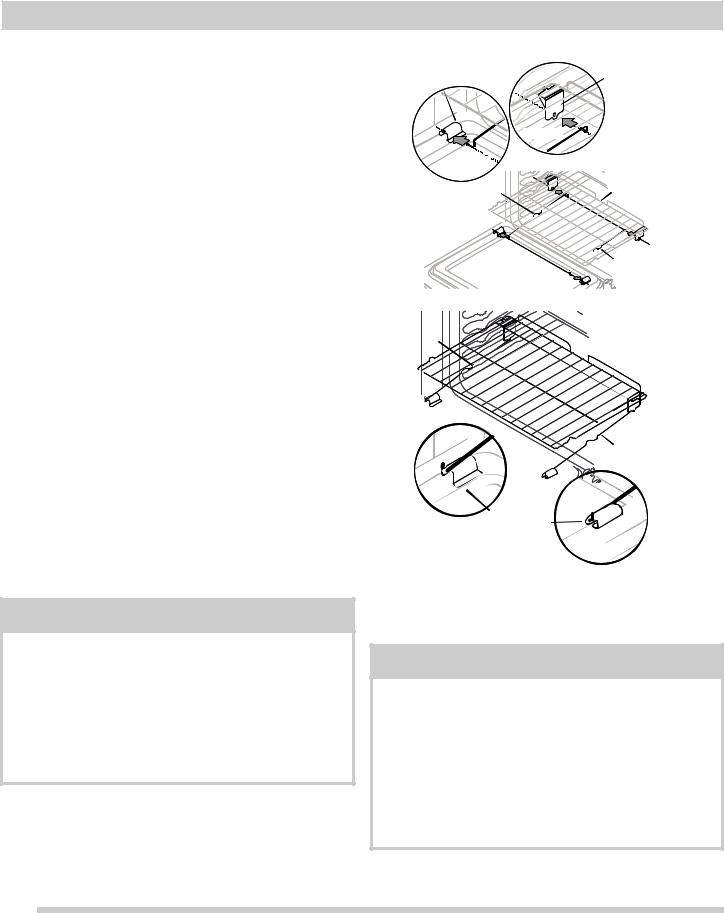
BEFORE SETTING OVEN CONTROLS
Effortless™ Oven Rack system
Some models are equipped with a special oven rack system that automatically extends the oven rack to assist in access to your food items. This rack extends when the oven door is opened or closed.
To assemble the Effortless™ Oven Rack system:
1.Locate all required parts. You will need the supplied oven rack. Effortless™ Oven Rack is a flat rack with a special dark coating on the left and right rack sides and the two supplied chrome connector arms.
2.Be sure the oven is completely cool before proceeding. Open the oven door.
3.Place the oven rack in positions 1,2, or 3. Be sure the rack connector brackets are at the rear of the range and pointing towards oven bottom Figure 2).
4.Assemble one connector arm at a time. With the oven door open and the oven rack in place, install one end of the connector arm to the hole in the door connector bracket (Figure 1) and the other end in the hole in the rack connector bracket (Figure 2 and as in Figure 3). The oven rack may need to be adjusted in or out in the rack position to match the length of the connector arm.
5.While holding the connector arm in place, twist the connector arm so the ends of the connector arm point upwards (See Figures 4 & 5). The connector arm should now be locked into position.
6.Repeat steps 4 and 5 for the other connector arm.
7.Once both connector arms are properly in place, be sure to test the oven rack operation by gently closing the oven door. The oven rack should move in and out of the oven freely when the door is opened or closed.
 IMPORTANT
IMPORTANT
Only the Effortless™ Oven Rack system performs best when connected and used in oven rack position 2.
If the rack system is assembled with the connector arms, the Effortless™ Oven rack may be used in oven rack positions 1, 2, and 3.
To prevent possible damage to the oven, do not attempt to close the oven door until all the oven racks are fully positioned back inside the oven cavity.
Door |
Rack |
|
connector |
||
connector |
||
bracket |
||
bracket |
||
|
||
|
Figure 2 |
|
Figure 1 |
|
|
Connector arm |
Oven rack |
Connector arm
Open oven door
Figure 3 - Assembly of the EffortlessTM oven rack
Connector arm
Figure 4
Connector arm
Left and right door connector brackets with
connector arm ends Figure 5 shown in locked position
(pointing upwards)
Figure 6 - Effortless™ oven rack after assembly
Figure 7:
 CAUTION
CAUTION
Remove all oven racks and accessories before starting a self-clean cycle. If the oven racks are left in the oven during the self-clean cycle, the gliding ability of the Effortless™ Oven Rack system will be damaged, and oven racks will lose their shiny finish and may turn blue. Remove all oven racks and clean according to instructions provided in the Care & Cleaning section of this manual. Make sure the oven and oven racks are completely cool when trying to assemble or disassemble the Effortless™ Oven Rack system.
12
